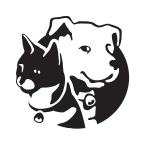Is Your Dog Dog-Friendly?
- Jones Animal Behavior

- Apr 4, 2019
- 3 min read
Updated: Feb 19, 2022

If you said "yes," congratulations! You are among a small group of about 10% of the dog population. If you said "no" or "sometimes," rest easy. You are among the majority of 90% of dogs - including my own dog - who dislike or have mixed feelings about other dogs. When our dogs aren't great with other dogs, it can be embarrassing or you may even wonder if something is wrong with your dog. Rest assured that is rarely the case since,.

Many dogs show aggression toward other dogs only when behind a barrier, such as a door or fence, known as barrier aggression. A great example of the role barriers can play in dog aggression is demonstrated here. As you watch, please keep in mind the video is NOT funny. These dogs are under a great deal of stress and enduring such distress day after day can not be a fun time. In fact, it can cause long-term health and behavior problems. The same holds true for our own dogs barking along physical fences, invisible fences, and out windows. There is a lot that can be done for these dogs with assistance from a professional. One great management tool you can try right away for dogs who bark out the window is to cover the windows with frosted window film. Available at most home improvement stores or online, blocking all areas dogs can see other dogs through not only reduces barking - it also allows sunlight in. While they calm down, reach out to a pro for help!

Other dogs are aggressive primarily when on leash, some of which may change entirely once the leash is removed. Unfortunately, this is often related to frustration with the leash itself. The following section was so perfectly written by Michael Shikashio of Complete Canines LLC, that I've copied word for word this useful information.
"Some things owners might inadvertently do that can trigger, or otherwise exacerbate their dog's undesirable on-leash behavior: - Tightening up on the leash to prepare for the "incoming storm" --- this also restricts movement and often removes the "flight" option or builds "frustration." - Teaching for treats or presenting the dog a treat BEFORE they notice the "scary thing" - Regularly cueing the dog to do something (ex: "watch me") BEFORE they notice the "scary thing." - Movement changes such as slowing down the pace or raising arms and shoulders preparing for a tense moment. - Or even something as subtle as changes in the client's respiration rate or even holding their breath when they see the "scary thing" approaching.
ALL of the above can end up prepping a dog to "get ready...the scary thing is ABOUT to show up!" So while dogs can have wonderful intuition into their owner's emotional state, we have to be aware of all the other things that can add fuel to the fire."
Whether it's barrier, window, or leash aggression more and more owners, especially those who adopted their dog as an adult, simply don't know how what to do. Will their dogs react? Or be fine? Many owners know their dogs need help, while other owners know that they are the one in need of training. In some cases, a dog may be simply overwhelmed by other dogs and needs carefully controlled play time. In other cases, a dog needs help learning how to improve social skills so they can play nicely. But in most cases, there are options.

I happen to have just the thing. For any area dogs and their people who are looking for help, I am proud to partner with Erika Lessa of Cooperation Canines for an exciting and unique program called It's a Date! One version is designed to teach owners about dog play in general, and their dog in particular. This version helps to identify and facilitate dog play when appropriate, and make behavior modification available when needed. The sister version of It's a Date is designed specifically for shelters and rescues, to teach personnel how to create and manage on-going playgroups for the dogs in their care. To learn more about either option, click here for details.
Regardless of how your dog acts around other dogs, there may be options for improving their behavior as well as their feelings. I strongly recommend that you never attempt to address aggression on your own and instead work with a skilled professional.
And for any geeks like me who were wondering: yes, dogs DO smell fear!





Comments